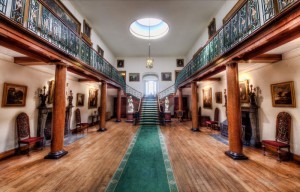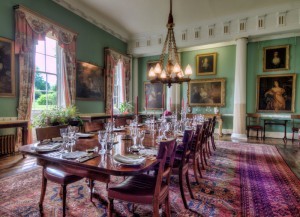Wellington’s Places: Brynkinalt Hall
Some Welsh and Irish connections
By Dr. Mick Crumplin
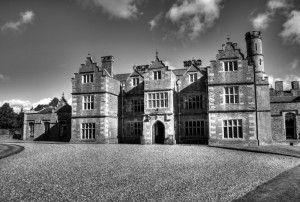
Brynkinalt Hall
(Courtesy of the Trevor family)
Brynkinalt Hall will be little known as a house where Arthur Wellesley often stayed. It was there that, as a small boy, he would happily reside with his maternal grandmother, the 1st Countess Dungannon. The hall sits on the historic route from London to Holyhead, so it was a convenient stopping place for Arthur Wellesley, en route to Ireland.
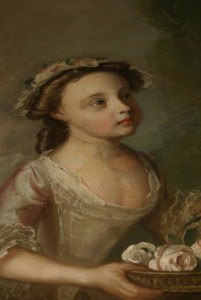
The young Anne Hill, Countess of Mornington, the first Duke of Wellington’s Mother. (Courtesy of the Trevor family)
Brynkinalt is presently the seat of the Right Honourable Lord Trevor, 5th Baron, and descendant of a family who have occupied the site since 924.1 Arthur Wellesley’s mother was Anne Hill. She was daughter of a banker Arthur Hill – later Hill-Trevor – 1st Viscount Dungannon, of the second creation, who had inherited Brynkinalt. Anne married 2nd Baron, Lord Mornington (later the 1st Earl), Garret Colley Wesley, who became the first Professor of Music at Trinity College, Dublin.
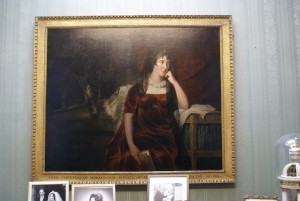
The Countess of Mornington in later years
(Courtesy of Kate Hill-Trevor)
It is from Brynkinalt that one of the few stories of young Arthur originates. He had befriended a blacksmith’s apprentice, with whom he became quarrelsome over a game of marbles. In a bout of fisticuffs, Arthur was bested by the lad, Hughes by name, and was apparently berated by his sister for fighting with servants! Later in life, Hughes, who died in 1849, would relate this tale with glee, since he was unutterably proud of having beaten the man, ‘before whom Napoleon and all his marshals went down’. He commented on the behaviour of the future Duke: ‘master Wesley bore him not a pin’s worth of ill-will for the beating, but made him his companion in many a wild ramble after the fight, just as he had done before’.
The family were friendly with Sarah Ponsonby and Eleanor Butler, better known as ‘The Ladies of Llangollen’, who lived in Plas Newydd in that town, and Arthur was sometimes a visitor to this unusual household. Sarah and Eleanor had a long-standing and strong relationship, which had gone against their families’ grain. Despite many attempts to marry the ladies off and other ‘protective’ manoeuvres, the two ladies were forced to elope and live together in tranquillity in a house they developed in Gothic style in the isolated Vale of Llangollen.

The two ‘Ladies of Llangollen’ – Eleanor Butler and Sarah Ponsonby
(Courtesy of Plas Newydd Llangollen)
Their house was decorated with many items of antiquity, removed from churches and sundry ancient buildings. They were a most cultured couple, who had gained many friends and visitors. Rumours of the nature of their relationship flourished and still do, but they seemed to live in an idyllic world, gardening, collecting and entertaining those of whom they were fond. Plas Newydd became a famous place to visit, but entertain as they did, few were invited to stay in the house.
Literary artists, such as Lady Caroline Lamb, Shelley, Sir William Wordsworth, Lord Byron and Sir Walter Scott visited the couple. Amongst many other renowned visitors was the 1st Duke of Wellington, one of the few visitors allowed to spend the night at the Ladies’ home! They had thought little of young Arthur when they first met him and wondered what the world would make of him. One of the few options was for him to join the army. On his return from India, he made a much-improved impression on them and he presented them with two large lion-like sculptures, which adorn the front entrance of Plas Newydd.

Plas Newydd in Llangollen, North Wales
(Author’s collection)
Sarah Ponsonby was related to the well-known Ponsonby cousins of Waterloo fame. She was a second cousin of Frederick Ponsonby, 3rd Earl of Bessborough, who had married Henrietta Spencer, daughter of John, 1st Earl Spencer. One of the 3rd Earl’s children was the renowned Major General the Honourable Sir Frederick Cavendish Ponsonby, a hero of the Peninsula (he was present in Iberia from 1809 until 1814 and was wounded on the retreat from Burgos). He most notably, sustained several injuries at Waterloo. Major General the Honourable Sir William Ponsonby, commander of the Union Brigade at Waterloo, who was fatally injured on the 18th June 1815, was a second cousin to Sir Frederick.
Even the small and tranquil settlement of Llangollen (now the site of the well-known International Eistedfordd) was involved in the war effort. A company of Llangollen Volunteers was raised in 1803.
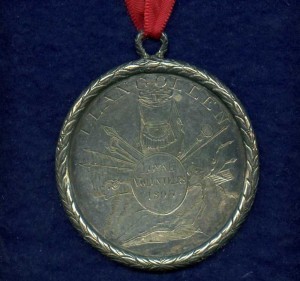
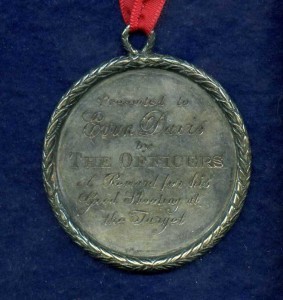
Obverse and reverse of a shooting medal, awarded to a volunteer in the Loyal Llangollen Militia in 1803 (Author’s collection)
The A5 road is an old and historic one. It took travellers from London to Holyhead and so would have been used by Wellesley on many occasions. Brynkinalt lies near a village called Chirk, on the Welsh border, making it a convenient stop. A similar grand house nearby, built in 1671 and eventually passing to the 2nd Earl of Bradford, was Weston Park. On one occasion I stayed there at a surgical examiners’ function and was interested to find in my bedroom a drawer of the blanket press in the room labelled in pencil, ‘the Duke of Wellington’s slippers’. One has to surmise that items of clothing were kept by such people at regular stop-off places!
Another ancestor of the present Hill-Trevor family was Captain Lord Arthur Hill, 2nd son of Arthur, Marquis of Downshire, who was later Lord Sandys. He was an extra ADC to the Duke at Waterloo
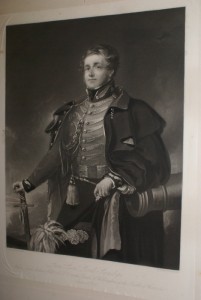
Captain (ultimately Lieutenant General) Arthur Hill, Lord Sandys, one of Wellington’s staff at the Battle of Waterloo
(Courtesy of the Trevor family)
What about the Brynkinalt itself? The hall is a Grade II (star) listed building. The main and central section of the house was the part completed by Sir Edward Trevor in 1612. The three-storey building was constructed from brick, cut on site. The Great hall in the central part of the house was originally an open courtyard, into which coaches entered by an arch where the present staircase is situated. Those parts of the house adjacent to the archway were used as bakery, stables and an ale-house.
In 1808, Charlotte, Viscount Dungannon extensively remodelled the house and her tastes were reflected in the grounds and parklands. The garden is a picturesque landscape, sporting Gothic features and an unusual tunnel, which leads to the kitchen garden. The 3rd and 4th Barons worked hard to retain the family property and removed much of the Victorian features previously added, in particular the plaster rendering, so restoring the fine original brickwork.
The hall contains several items of interest, concerning the life and career of the 1st Duke.
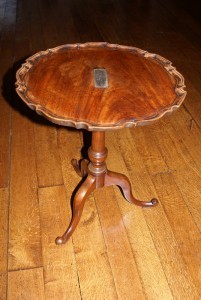
A small wine table, with a plaque engraved, ‘Lieut. Col. Wellesley 33rd Regt. Foot’. This was presented by the officer’s mess of the 33rd (West Riding) Regiment to Arthur Wellesley on his departure from service in India. This had been his first battalion command.
(Courtesy of the Trevor family)

A bejewelled bracelet, given by the Duke of Wellington to his mother.
(Courtesy of the Trevor family)
In 1967, Charles Edwin Trevor, 4th Baron, married Susan Bence, daughter of a well-qualified and decorated doctor. They had two sons, Marke Charles, the current 5th Baron Trevor, and Iain, married to Kate and now named Hill-Trevor. Today, this magnificent hall and estates are well run by this couple and offer diverse commercial and recreational opportunities. There are rural offices in the Brynkinalt Business Centre, also industrial units and residential cottages. The grounds offer facilities for shooting, farming and woodland trade. The hall provides an excellent setting and location for corporate and private functions.
This is a little-known but precious structural jewel in the saga of the 1st great Duke. Other houses and premises are Stratfield Saye, Apsley House (‘No;1, London’) and Walmer Castle – all to be the subjects or future articles.
I would like to acknowledge the help and guidance of Kate and Iain Hill-Trevor in the preparation of this article – also the support of Plas Newydd in Llangollen
Footnotes:
- The Trevors are direct descendants of a union (942) between Tudur Trevor, King of Gloucester and Angharad, daughter of Howel Dda, King of Wales. Both Tudur and Angharad could trace their pedigrees back to the Emperor Maximus, King Vortigen and Llewellyn, Prince of Wales. Prior to living at the site of Brynkinalt (where the family have lived since 924), they occupied Whittington Castle. Being the Head of the Tribes of March, from there they governed large tracts of land between the Rivers Wye and Severn.
Sir Edward Trevor completed the present house in 1612 and the family remained loyal to the Crown throughout the Civil War. Sir Edward’s son, Marke, was created 1st Viscount Dungannon by Charles II, for wounding Oliver Cromwell at the Battle of Marston Moor in 1644. On the death of Marke’s son and then his grandson (the 2nd and 3rd Viscount Dungannon, respectively), the title died out. The house and estates meanwhile passed to Sir John Trevor, Kt, PC, grandson of Sir Edward Trevor, in 1706. Sir John’s son – another John Trevor, became a judge, was elected Speaker of the House of Commons, Master of the Rolls, Lord Commissioner of the Great Seal and a Privy Councillor through the reigns of James II, William and Mary and Queen Anne. As once pointed out by George Tonypandy, there have only been two Welsh Speakers in the House in six hundred years. Sir John Trevor had been the first.
When the latter Sir John died in 1717, the property passed to his two sons successively. When the last of these died in 1762, Brynkinalt and its estates were inherited by the second son of Anne Trevor. Anne was Sir John’s sole surviving child. Anne had married twice, her first union being to Michael Hill MP. From this marriage came two sons, the second of which, was Arthur Hill, created 1st Viscount Dungannon – but of the second creation. His son (Arthur) died before his father, so did not inherit the title, estates and property. Thus Brynkinalt then passed to his son, yet another Arthur, grandson of the 1st Viscount, who in turn, became the 2nd Viscount of the 2nd creation. Arthur, the 2nd Viscount had married Charlotte (whose godmother was Queen Charlotte, wife of George III), who was instrumental in transforming the Jacobean House into its present design.


